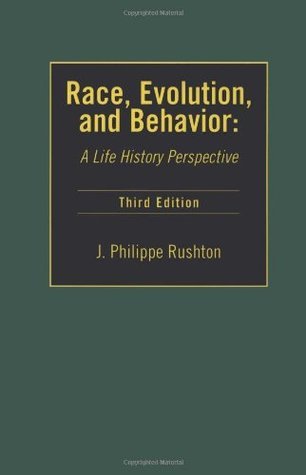What do you think?
Rate this book


388 pages, Paperback
First published August 1, 1994
1) r/K selection theory is largely obsolete;The first thing that needs to be said regarding r/K selection theory is that modern ecology has generally, if not wholly abandoned the theory, at least moved beyond it to more sophisticated models of life-history trade-offs.
2) On theoretical grounds, Africans would be more not less K-selected than other races;
3) There is no obvious connection between many traits that Rushton describes and r/K selection.
“Among r-selected species… fighting would be a waste of their most precious commodity: time” (Ethology: The Mechanisms And Evolution Of Behavior: p367)Body-Size
“It’s a trade off, more brains or more penis. You can’t have everything.”Actually, the quote is probably apocryphal or perhaps a misinterpreted joke. Rushton's theory does not suggest a direct trade-off between penis and brain size.
“Nigerian men have testes more than twice as large as those of Hong Kong Chinese” (Sexual Selection and the Origins of Human Mating Systems: p31)Yet he also reports that Nigerians also have lower sperm counts than Europeans or Chinese (Sexual Selection and the Origins of Human Mating Systems: p53)—and a recent study of US military recruits reports larger testes among whites than blacks (Dutton et al 2022).
“A strong point of differential K theory is its apparent parsimony. A large number of seemingly unrelated differences can be explained by a single evolutionary theory. If many of the differences trace to a single direct cause, sex hormone levels, or other ultimate causes that act through the sex hormones, then other theories are equally parsimonious.”Paternal Investment Theory
“Colonising temperate and cold environments leads to increased cognitive demands to solve the problems of gathering food and gaining shelter and general survival in cold winters” (p228).This, he argues, is because, outside the tropics, plant food is available only seasonally, hunting is more difficult and individuals must develop technologies such as clothing, fire and shelter to keep warm.
“Hunting in the open grasslands of Northern Europe was more difficult than hunting in the woodlands of the tropics and subtropics where there is plenty of cover for hunters to hide in” (p228).But, if hunting is aided by greater availability of cover in Northern Europe, then this presumably assisted predators in hunting humans just as much as it helped humans in hunting for themselves—and there is no obvious reason why the greater difficulty of avoiding predation in Africa would not have selected just as strongly for intelligence as the greater difficulty of hunting in temperate zones.